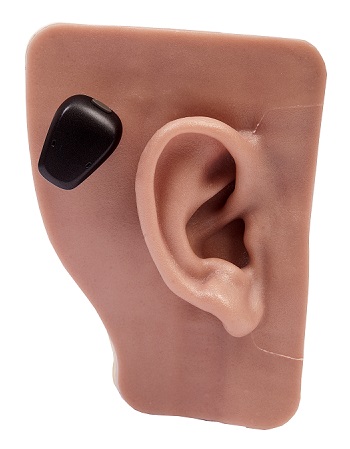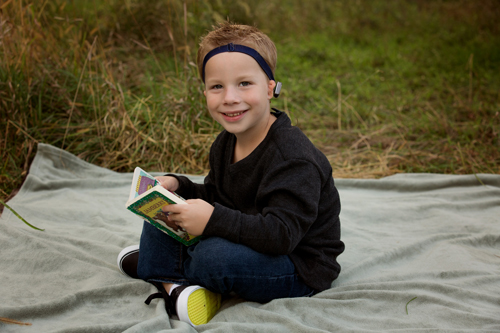A bone conduction hearing aid (also known as an auditory osseointegrated device (AOD)) is designed to transfer sounds through bone conduction to the inner ear. The system consists of a
sound processor (bone conduction device) and a
coupling mechanism.
- The bone conduction device picks up sounds using microphones.
- The device then changes the sound to vibrations and sends it to the child's skull through an abutment, a magnet located just under the skin, or through a softband.
- The sound travels to the inner ear through bone conduction and bypasses any problems in the outer and/or middle ear.
The bone conduction device makes contact with the head one of three ways:
- Children under 5, those who are not surgical candidates, or for those that do not wish to have surgery: the bone conduction device attaches to a soft headband (softband) that the child wears on their head.
- For children 5 years old and older and adults that are candidates for surgery: the auditory osseointegrated system attaches to the head through one of two different ways:
- A small implant in the mastoid bone behind the ear which is connected to an abutment that sticks out through the skin. After bone has grown around the implant and abutment, the bone conduction device snaps into the abutment and the softband is no longer needed to hold the device on the head.
- A magnet which is implanted in the bone just under the skin behind the ear. An external magnet attached to the bone conduction device is used to connect the two pieces and send the signal across the skin.

Is My Baby a Candidate for a Bone Conduction Hearing Aid?
Children who are considered candidates for a bone conduction system are not able to use or benefit from traditional hearing aids:
- Children that have a conductive hearing loss (a hearing loss involving the outer or middle ear) or a mixed hearing loss (a hearing loss that affects the outer or middle ear as well as the inner ear).
- Children and adults with single-sided deafness (a profound hearing loss in only one ear) and normal or near-normal hearing in the opposite ear.
- Hearing aids may be attempted first in some cases but for some hearing aids may not be an option.
Some children are born with conditions that result in conductive or mixed hearing losses. Some of the more common conditions are:
- Aural atresia (no ear canal or opening to the ear canal)
- Ear canal stenosis (small ear canals)
- Abnormalities with the bones in the middle ear space
Other children develop a conductive or mixed hearing loss later in life due to chronic infection or disease in the middle ear, cholesteatomas or chronic drainage that prevent the use of a hearing aid.
It is important that your child be evaluated by a team who is familiar with auditory osseointegrated systems before proceeding with amplification.
An audiologist will need to determine:
- The softest sounds your child can hear through speakers, headphones or a bone conduction headband.
- The bone conduction thresholds for at least one ear will be needed before determining if your child is a Bone Conduction Hearing Aid candidate.
- The audiologist can obtain these measurements through a behavioral hearing test or through an auditory brainstem response (ABR) test.
- Your child will also need to be seen by an Otolaryngologist [Ear, Nose, and Throat (ENT) physician] to determine if a Bone Conduction Hearing Aid is an appropriate and safe step for your child.
If your child is a candidate for the device, a trial period should be completed using a loaner device on a softband. If you and the team feel there is an improvement in your child's ability to hear and your child tolerates the device, you can move forward in obtaining a Bone Conduction Hearing Aid for your child to keep.
What are the different types of Bone Conduction Hearing Aids?
There are 3 primary companies who manufacture Bone Conduction Hearing Aids and systems. Each company has different digital devices that are chosen based on the severity of the hearing loss and the amount of power needed for the child to hear.
The three primary companies that manufacture bone conduction hearing aids are:
- Cochlear Americas
- New processors include: Baha 5, Baha 5 Power, and Baha 5 SuperPower
- The Baha 5 processor makes contact with the skull via the Baha Attract, Baha Connect and softband.
- Oticon Medical
- New processors include: Ponto 3, Ponto 3 Power and Ponto 3 Super Power
- The Ponto 3 processors make contact with the skull through the abutment or through the softband.
- Sophono, Inc.
- Devices include: Alpha 2 MPO devices
- The Alpha 2 MPO processor makes contact with the skill only through a magnetic system and not an abutment option or a softband.
How is a Bone Conduction Hearing Aid fitted and evaluated on an infant or young child?
The Bone Conduction Hearing Aid is connected to the computer and is programmed specifically for your child.
- The first step is to enter the results from your child's hearing test into the programming software on the computer.
- The audiologist will then tell the computer information about the device such as which side it will be worn on and if it is worn on a softband, an abutment or a magnet.
- If your child is old enough, they will participate in a hearing test where they will hear beeps through the bone conduction device while it is connected to the computer.
- They will raise their hand or play a game every time they hear the beep. This is called "in-situ bone conduction" testing.
- Once the device has been fitted for your child, a hearing test will be completed.
- Your child will be tested in a sound booth and respond to speech through the speaker while wearing the device to determine what he/she can hear with the device.

Features of Bone Conduction Hearing Aids
Much like a traditional hearing aid the bone conduction devices come with some extra features making them kid friendly. Some of those features include:
- Color options for the devices and softbands
- Stickers to put on the devices
- Indicator lights
- Tamper resistant battery doors
- Safety/retention cords
- Telecoil (to be used with the telephone or some FM systems)
- FM System compatibility
Each device also comes with tools for cleaning and troubleshooting: abutment covers, cleaning brush and a listening test rod.